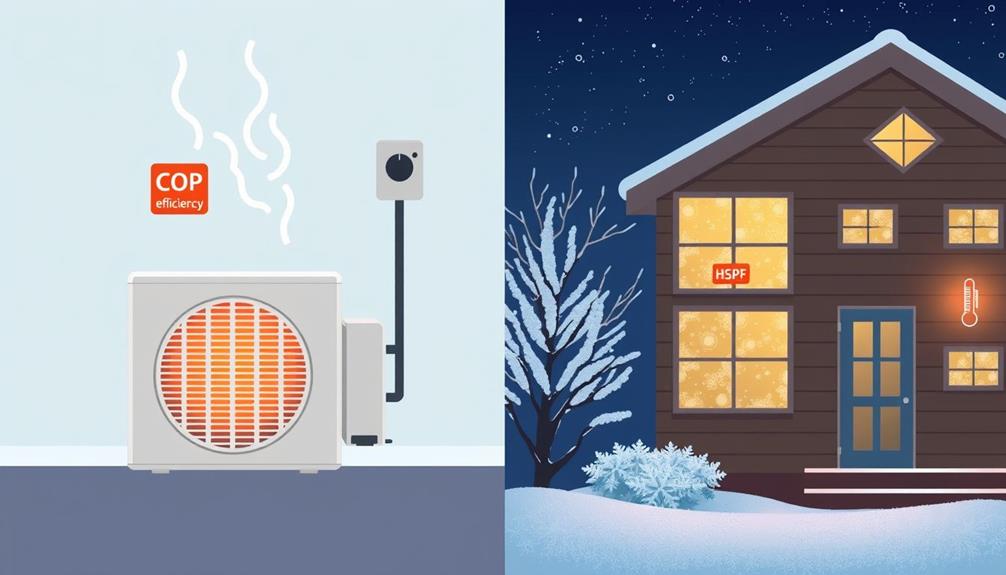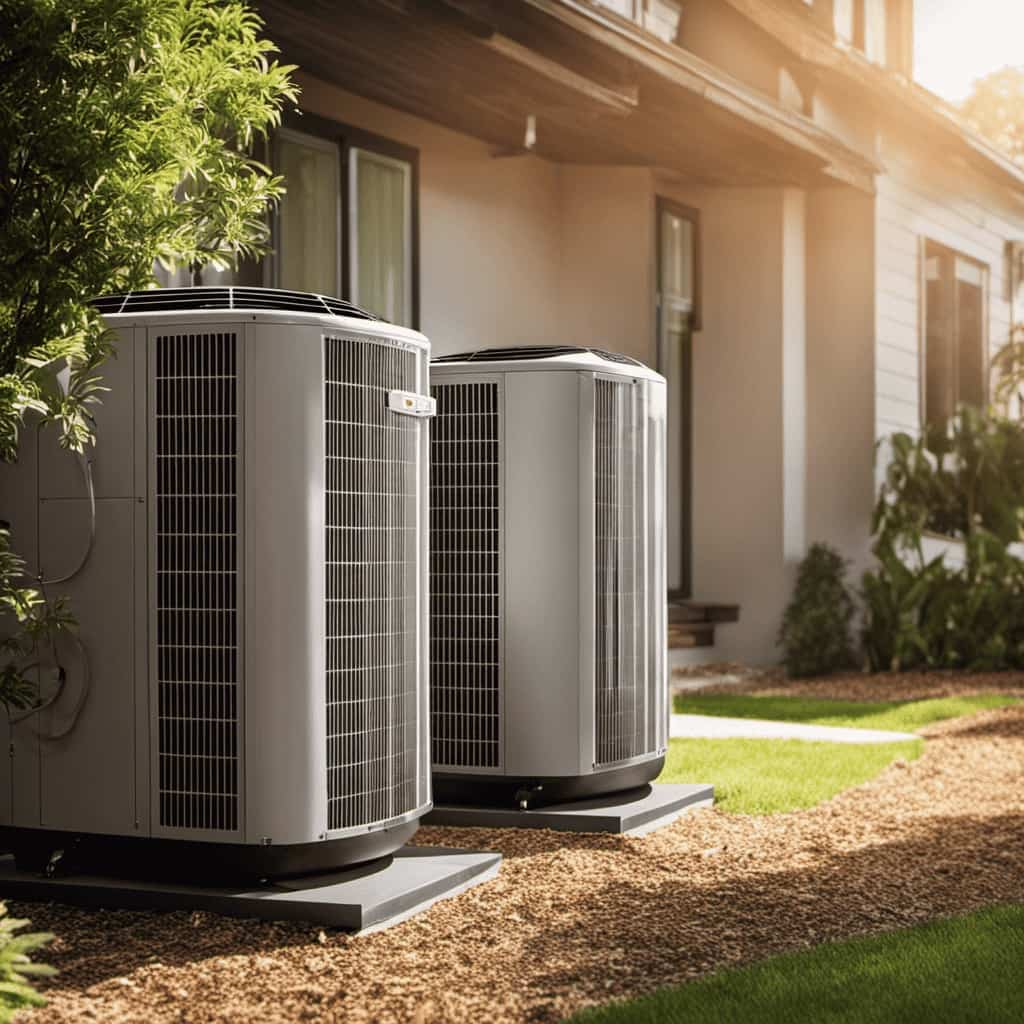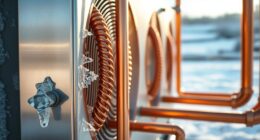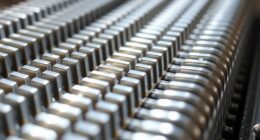Calculating ROI on energy-efficient heat pumps involves several key steps. First, you need to assess your initial investment, which typically ranges from $10,000 to $15,000. Next, estimate your annual energy savings, which can be around 30-50% compared to traditional systems. Don't forget to factor in maintenance costs, usually between $150 and $300 yearly. You'll also want to look for available financial incentives that can ease upfront costs. By calculating the payback period—typically under 10 years—you can determine how quickly you'll recoup your investment. Stick around to reveal more insights on optimizing your ROI!
Key Takeaways
- Heat pumps can achieve energy savings of 30-50% compared to traditional heating systems, significantly lowering annual energy costs.
- Initial investment for heat pumps ranges from $10,000 to $15,000, with potential grants reducing net costs.
- The payback period for heat pumps averages around 7-10 years, depending on savings and installation costs.
- Long-term ROI can yield substantial cumulative savings over 15-20 years, factoring in maintenance and operational costs.
- Regular maintenance is essential to ensure optimal performance and extend the lifespan of heat pumps.
Understanding Heat Pump Technology
Understanding heat pump technology starts with recognizing how these systems work. Unlike traditional heating systems, heat pumps transfer heat rather than generate it, making them three times more efficient in delivering heat relative to the energy consumed.
There are two main types of heat pumps: air-source heat pumps (ASHPs), which extract heat from the outside air, and ground-source heat pumps (GSHPs), utilizing the stable temperatures of the earth. Thermal energy transfer basics play an essential role in how these systems function effectively.
To assess their performance, you'll want to look at the Energy Efficiency Ratio (EER) and Seasonal Energy Efficiency Ratio (SEER). Higher EER and SEER numbers indicate better efficiency and lower operational costs, translating to significant energy savings over time.
While heat pumps can operate effectively in various temperatures, their efficiency may decrease in extremely cold conditions, often requiring backup heating solutions.
Modern heat pump technology includes advanced features like variable-speed compressors, which allow the system to adapt more effectively to changing temperatures. This adaptability not only enhances energy efficiency but also improves overall comfort levels in your home.
Initial Investment Calculations

Investing in a heat pump involves several financial considerations beyond just the purchase price of the unit. The initial investment typically ranges from $10,000 to $15,000, including installation costs. However, you need to factor in additional expenses for necessary upgrades to your insulation or heating distribution systems to achieve ideal energy efficiency.
Additionally, consider investing in Garage Door Openers to enhance your home's overall energy efficiency and security.
Your property's size plays an important role in determining the overall investment required. Larger homes may necessitate more powerful units or multiple systems, which can increase costs. To guarantee effective financial planning, it's vital to assess all associated costs, including potential permits and local regulations that may arise during heat pump installations.
Additionally, don't overlook the impact of available grants, such as those provided by SEAI. These can greatly lower your net initial investment, making it easier for you to afford an energy-efficient heat pump.
Estimating Annual Energy Savings

To estimate your annual energy savings after switching to a heat pump, start by determining your current heating system's baseline energy consumption.
Regular inspections of your heating system can prevent inefficiencies and guarantee peak performance, much like how toilet maintenance extends lifespan of plumbing fixtures.
Then, calculate the expected consumption of the new heat pump to find the difference.
This straightforward comparison will give you a clear picture of your potential savings.
Baseline Energy Consumption
Estimating annual energy savings from heat pumps starts with pinpointing your baseline energy consumption. This initial step involves reviewing your utility bills or having an energy audit performed.
In a typical household, heating energy consumption ranges from 12,000 to 20,000 kWh per year, influenced by factors like home size and climate. Utilizing well-draining soil mix for your garden can also contribute to reducing energy costs indirectly by enhancing your home's overall energy efficiency.
Energy-efficient heat pumps can cut heating costs by about 30-50% compared to traditional systems, leading to significant energy efficiency. For instance, if your old heating system consumes 1,756 kWh annually and a new heat pump is projected to use only 1,200 kWh, your annual savings would be 556 kWh.
To refine your estimates, consider using online calculators that take into account local energy rates, heat pump efficiency ratings (COP), and heating load calculations.
Post-Upgrade Savings Calculation
Calculating your post-upgrade savings can reveal the true benefits of switching to an energy-efficient heat pump. To start, you need to establish your baseline energy consumption. This is typically based on past utility bills, which average around $1,756 per year for conventional systems.
After upgrading, you'll find that the operational costs of your new heat pump are approximately $477 annually. By using the formula for annual savings—Annual Savings = Baseline Usage – Post-Upgrade Usage—you can calculate your post-upgrade savings. In this case, you'll see about $1,279 in annual savings.
Incorporating practices like regular monitoring of energy consumption can help optimize your savings further. Energy audits can further refine this calculation by evaluating specific energy usage patterns and the efficiency improvements achieved during your upgrade.
It's also essential to engage in regular monitoring of energy consumption after the upgrade. This practice helps guarantee that your savings remain consistent and allows you to spot any potential inefficiencies in your energy-efficient heat pump.
Ultimately, this comparison between your old system and the new one highlights the financial benefits of your investment, making it clear that the switch was a smart decision.
Financial Incentives and Rebates
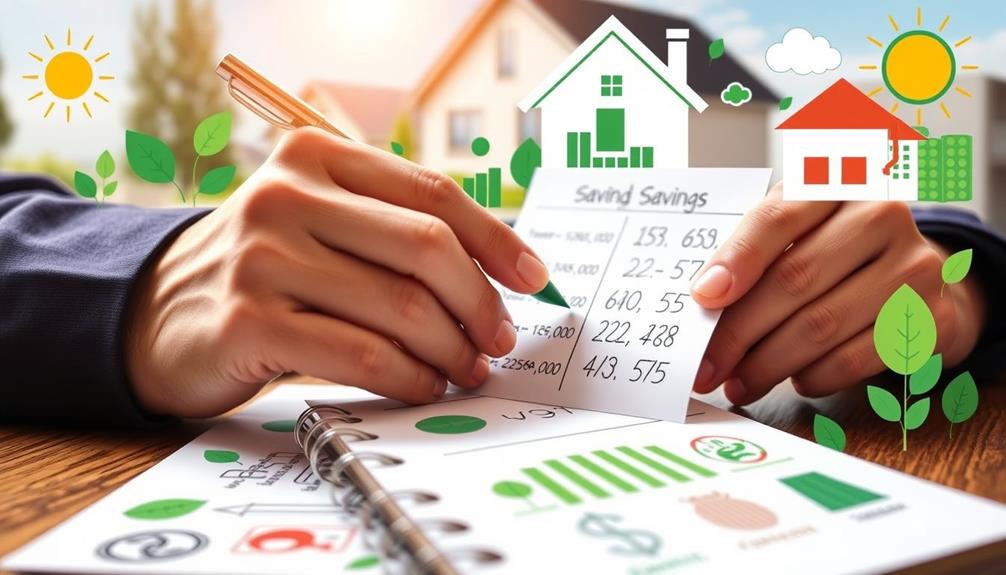
When considering the installation of energy-efficient heat pumps, tapping into available financial incentives and rebates can greatly reduce your initial costs. Many states provide generous rebates for residential energy improvements, markedly lowering your upfront costs.
Additionally, exploring options like a Gold IRA conversion can be a strategic move to safeguard your retirement while investing in energy-efficient home improvements. Utility companies often offer incentive programs that reimburse you for purchasing energy-efficient appliances and HVAC systems, enhancing your overall financial savings.
Although tax credits for energy efficiency expired in 2016, you still have options to make your investment more manageable. Low- or no-interest loans are available, allowing you to finance the installation of heat pumps and other energy-saving measures without breaking the bank.
By exploring these opportunities, you can maximize your savings and make your shift to energy-efficient upgrades smoother. The availability of these financial incentives varies by location, so it's important to research local programs that apply to you.
Whether it's through state rebates or utility company incentives, understanding your options can lead to substantial cost reductions. In the end, leveraging these financial incentives not only helps with upfront costs but also paves the way for long-term energy savings.
Calculating the Payback Period

Calculating the payback period is essential for understanding how quickly you'll recover your investment in an energy-efficient heat pump.
You'll want to take into account factors like your initial investment, annual savings, and any maintenance costs involved.
A holistic lifestyle approach can also complement your energy savings by promoting mindful practices that reduce overall consumption.
Understanding Payback Period
Evaluating the payback period for energy-efficient heat pumps is vital for homeowners looking to make informed financial decisions. The payback period gives you a clear view of how long it'll take to recoup your net initial investment through annual savings. To calculate this, simply divide the net initial investment by your annual savings from reduced energy costs.
For example, if your net initial investment is $10,000 and you save $1,279 annually, your payback period would be approximately 7.8 years. A shorter payback period—typically under 10 years—is considered a more favorable investment.
Here's a quick reference table to help you visualize the concept:
| Net Initial Investment | Annual Savings | Payback Period |
|---|---|---|
| $8,000 | $1,000 | 8 years |
| $10,000 | $1,279 | 7.8 years |
| $12,000 | $1,500 | 8 years |
| $15,000 | $1,800 | 8.3 years |
| $20,000 | $2,000 | 10 years |
Understanding this payback period is vital for evaluating the financial feasibility of installing heat pumps and comparing them to other energy efficiency options.
Factors Influencing Payback Period
Several factors influence the payback period for energy-efficient heat pumps, and understanding them can help you make better financial decisions.
First, consider the upfront installation costs, which average around $15,000 after rebates for a high-efficiency heat pump. Then, evaluate the annual savings; you could save approximately $1,279 compared to your old heating system.
According to tips on meal planning, financial planning for energy-efficient investments is just as important as planning your meals. To calculate the payback period, simply divide your net initial investment by these annual savings.
Energy efficiency ratings, like SEER and HSPF, play a critical role in determining energy consumption and overall savings.
Local climate conditions also matter; colder climates may lead to longer payback periods due to increased reliance on backup heating systems.
Additionally, don't overlook maintenance costs. Typically lower for heat pumps than traditional systems, these costs can influence your long-term savings and the effective payback period.
Long-term ROI Assessment
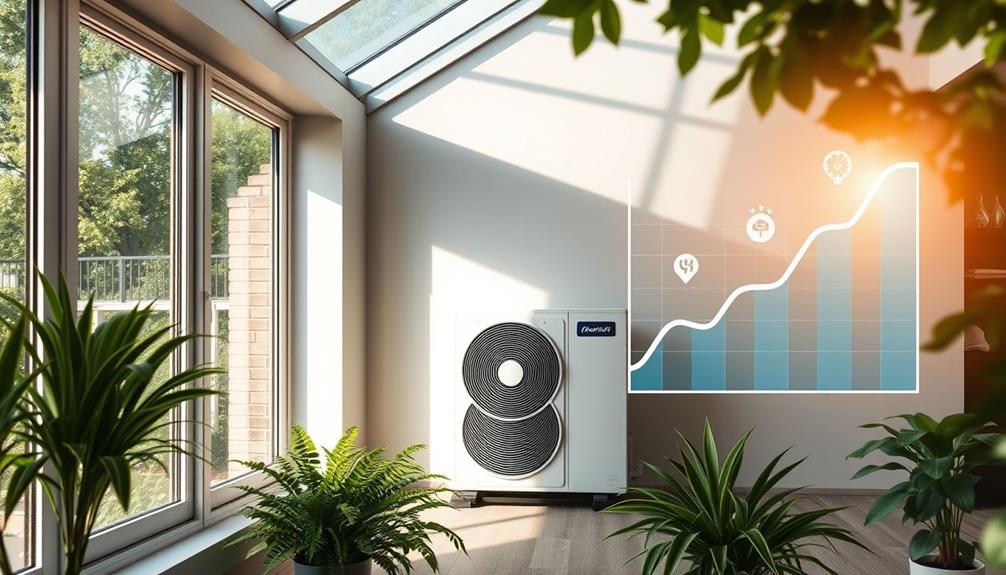
Evaluating the long-term ROI of energy-efficient heat pumps can reveal significant financial benefits over their lifespan. By measuring total savings, which typically span 15 to 20 years, you can better understand the impact of your upfront investment.
An energy-efficient heat pump might require about $15,000 initially, but it can save you around $1,279 annually compared to traditional systems. This leads to substantial cumulative energy savings over time. Implementing a holistic lifestyle approach can further enhance these savings by improving overall efficiency in home energy usage.
It's essential to factor in maintenance costs when calculating ROI. A well-maintained heat pump can achieve a COP (Coefficient of Performance) three times higher than conventional heating methods, enhancing your long-term energy efficiency.
Monitoring your energy consumption trends can also provide valuable insights, allowing you to tweak your system for best performance.
Maintenance and Operational Costs

How much are you willing to invest in maintaining your heat pump? Regular maintenance typically incurs annual costs between $150 and $300, which is generally lower than what you'd spend on traditional heating systems.
By performing routine maintenance tasks like filter replacements and coil cleaning, you can enhance your heat pump's efficiency and extend its lifespan by up to 15 years. Incorporating a modern farmhouse aesthetic into your home can also harmonize with the energy-efficient features of your heat pump.
Operational costs for heat pumps average around $477 annually, considerably less than the $1,756 you'd face with older heating systems. This efficiency translates to energy savings of approximately $1,279 each year compared to conventional methods, positively impacting your long-term operational costs.
To guarantee ideal performance, understanding your heat pump's maintenance needs, such as seasonal inspections, helps you budget accurately.
Making Informed Upgrade Decisions

When contemplating an upgrade to a heat pump, it's essential to weigh both the initial investment and potential savings. Start by evaluating the upfront costs of heat pump installation, including purchase and installation expenses. Investigate available financial incentives, like SEAI grants, which can notably lower your upfront costs and enhance the feasibility of your upgrade.
Additionally, it's wise to reflect on how the energy efficiency of your new system can lead to long-term savings on household expenses by reducing energy consumption.
Next, conduct an energy audit to compare your current heating costs with the projected operational costs of the heat pump. This will help you estimate your annual savings accurately. Remember to factor in maintenance costs, as heat pumps often incur lower expenses than traditional systems, contributing to long-term savings.
To make informed decisions, calculate the payback period by dividing the net initial investment by your annual savings. This calculation will clarify how quickly you'll recoup your investment.
Here are a few key points to contemplate:
- Evaluate upfront installation costs and financial incentives.
- Conduct an energy audit for accurate savings projections.
- Calculate the payback period to gauge ROI effectively.
Frequently Asked Questions
What Is the ROI on a Heat Pump?
You'll find that heat pumps can save you around $1,279 annually compared to traditional systems. Over their lifespan, these savings can cover your initial investment, making the ROI quite compelling for energy-efficient choices.
How Can a Heat Pump Be 400% Efficient?
A heat pump can be 400% efficient because it transfers heat instead of generating it. By moving four units of heat for every unit of electricity used, it maximizes energy efficiency, especially in moderate climates.
What Is the Payback for a Heat Pump?
The payback for a heat pump depends on your initial investment and annual savings. Typically, you'll calculate it by dividing the investment by savings, aiming for a period of 5 to 10 years for better returns.
How Can a Heat Pump Be 200% Efficient?
Imagine a magician pulling three rabbits from a hat instead of one. A heat pump can seem 200% efficient because it moves heat, delivering more energy than it consumes, achieving incredible performance even in challenging climates.
Conclusion
In the grand tapestry of home efficiency, investing in energy-efficient heat pumps can weave a brighter, more sustainable future. By understanding the ins and outs of ROI, you're not just crunching numbers; you're planting seeds for long-term savings and comfort. Embrace the journey of smart upgrades, and watch your savings bloom like a garden in spring. With every dollar saved, you're not just heating your home—you're fostering a greener planet for generations to come.



